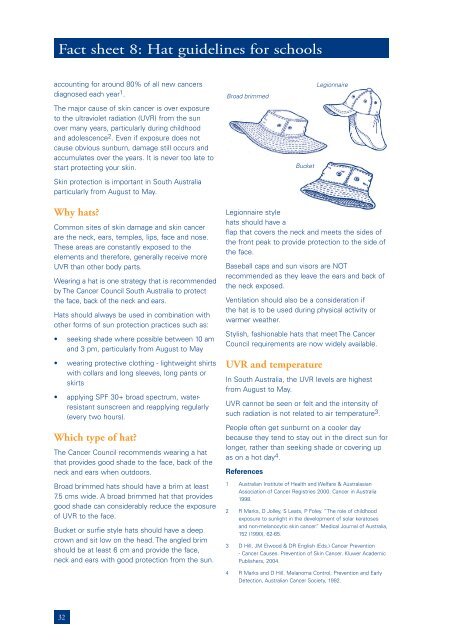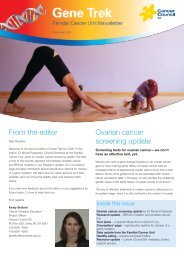Be SunSmart final print file.indd - Cancer Council SA
Be SunSmart final print file.indd - Cancer Council SA
Be SunSmart final print file.indd - Cancer Council SA
Create successful ePaper yourself
Turn your PDF publications into a flip-book with our unique Google optimized e-Paper software.
accounting for around 80% of all new cancers<br />
diagnosed each year 1 .<br />
The major cause of skin cancer is over exposure<br />
to the ultraviolet radiation (UVR) from the sun<br />
over many years, particularly during childhood<br />
and adolescence 2 . Even if exposure does not<br />
cause obvious sunburn, damage still occurs and<br />
accumulates over the years. It is never too late to<br />
start protecting your skin.<br />
Skin protection is important in South Australia<br />
particularly from August to May.<br />
Why hats?<br />
Common sites of skin damage and skin cancer<br />
are the neck, ears, temples, lips, face and nose.<br />
These areas are constantly exposed to the<br />
elements and therefore, generally receive more<br />
UVR than other body parts.<br />
Wearing a hat is one strategy that is recommended<br />
by The <strong>Cancer</strong> <strong>Council</strong> South Australia to protect<br />
the face, back of the neck and ears.<br />
Hats should always be used in combination with<br />
other forms of sun protection practices such as:<br />
•<br />
•<br />
•<br />
Fact sheet 8: Hat guidelines for schools<br />
32<br />
seeking shade where possible between 10 am<br />
and 3 pm, particularly from August to May<br />
wearing protective clothing - lightweight shirts<br />
with collars and long sleeves, long pants or<br />
skirts<br />
applying SPF 30+ broad spectrum, waterresistant<br />
sunscreen and reapplying regularly<br />
(every two hours).<br />
Which type of hat?<br />
The <strong>Cancer</strong> <strong>Council</strong> recommends wearing a hat<br />
that provides good shade to the face, back of the<br />
neck and ears when outdoors.<br />
Broad brimmed hats should have a brim at least<br />
7.5 cms wide. A broad brimmed hat that provides<br />
good shade can considerably reduce the exposure<br />
of UVR to the face.<br />
Bucket or surfie style hats should have a deep<br />
crown and sit low on the head. The angled brim<br />
should be at least 6 cm and provide the face,<br />
neck and ears with good protection from the sun.<br />
Broad brimmed<br />
Legionnaire style<br />
hats should have a<br />
flap that covers the neck and meets the sides of<br />
the front peak to provide protection to the side of<br />
the face.<br />
Baseball caps and sun visors are NOT<br />
recommended as they leave the ears and back of<br />
the neck exposed.<br />
Ventilation should also be a consideration if<br />
the hat is to be used during physical activity or<br />
warmer weather.<br />
Stylish, fashionable hats that meet The <strong>Cancer</strong><br />
<strong>Council</strong> requirements are now widely available.<br />
UVR and temperature<br />
In South Australia, the UVR levels are highest<br />
from August to May.<br />
UVR cannot be seen or felt and the intensity of<br />
such radiation is not related to air temperature 3 .<br />
People often get sunburnt on a cooler day<br />
because they tend to stay out in the direct sun for<br />
longer, rather than seeking shade or covering up<br />
as on a hot day 4 .<br />
References<br />
Bucket<br />
Legionnaire<br />
1 Australian Institute of Health and Welfare & Australasian<br />
Association of <strong>Cancer</strong> Registries 2000. <strong>Cancer</strong> in Australia<br />
1998.<br />
2 R Marks, D Jolley, S Leats, P Foley. “The role of childhood<br />
exposure to sunlight in the development of solar keratoses<br />
and non-melanocytic skin cancer.” Medical Journal of Australia,<br />
152 (1990), 62-65.<br />
3 D Hill, JM Elwood & DR English (Eds.) <strong>Cancer</strong> Prevention<br />
- <strong>Cancer</strong> Causes. Prevention of Skin <strong>Cancer</strong>. Kluwer Academic<br />
Publishers, 2004.<br />
4 R Marks and D Hill. Melanoma Control, Prevention and Early<br />
Detection, Australian <strong>Cancer</strong> Society, 1992.



